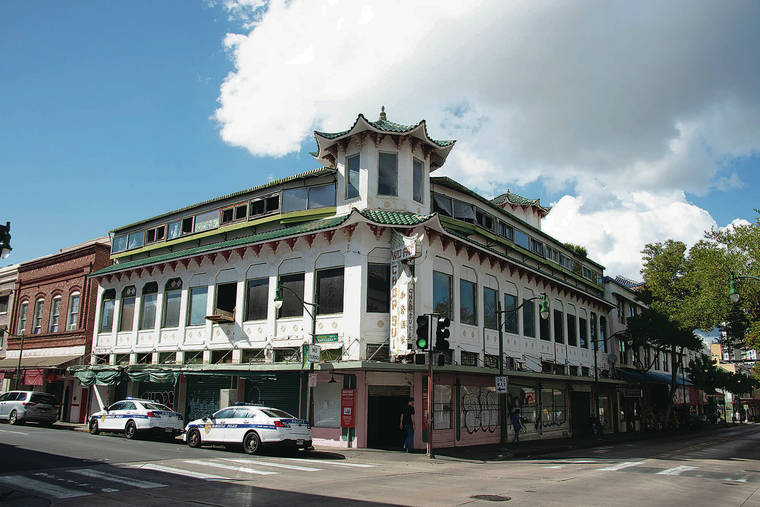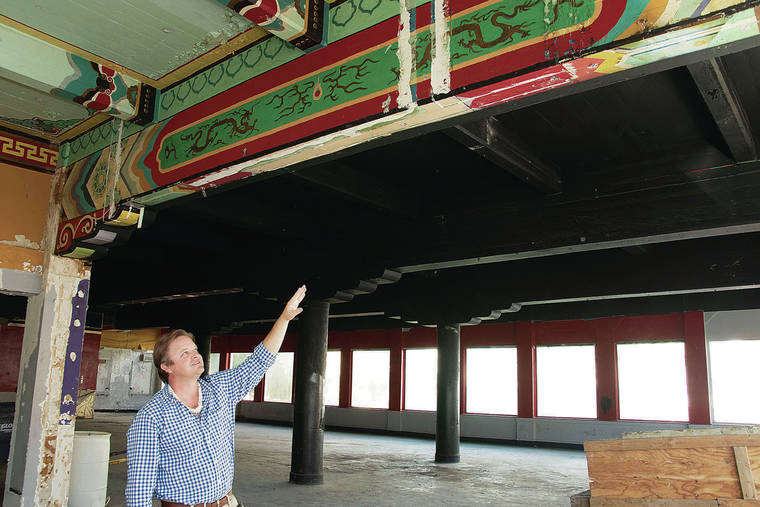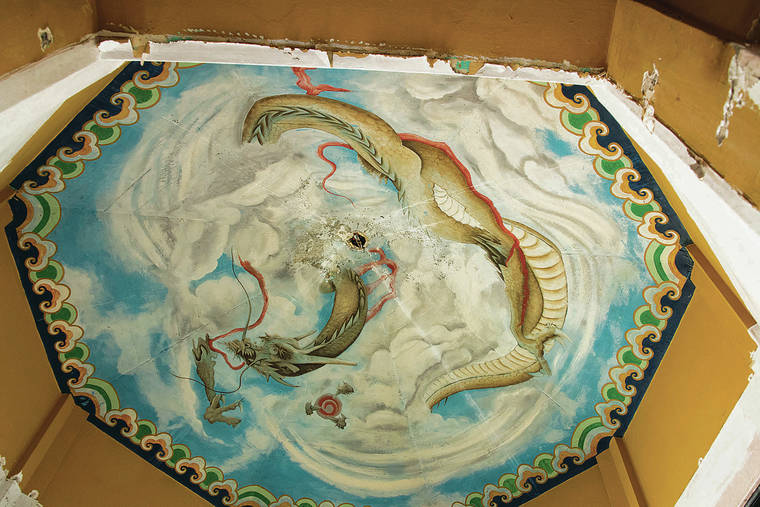Owners of the iconic Wo Fat Building are hoping that restoration of the 86-year-old landmark will serve as a catalyst for a badly needed makeover for the rest of Chinatown.
The Wo Fat project calls for a cafeteria-style eatery and some retail on the ground floor along historic Hotel and Maunakea streets, and a 23-room boutique hotel on the second and third floors in what for decades served as the main dining halls for one of the largest and most prestigious Chinese banquet restaurants on the island.
Mighty Wo Fat LLC, an investment group that includes former University of Hawaii football coach June Jones, presented its plan at a public hearing last week as part of its request for a Chinatown Special District Design permit. Acting Planning Director Kathy Sokugawa has until Jan. 21 to make a decision on the permit request.
The property was purchased for $4 million in July 2017 and the project is estimated to cost about $10 million. Project developers are seeking National Historic Register designation for the building, making it eligible for federal tax credits, the owners said.
“The scope of the project is a combination of historic preservation and adaptive re-use,” said Dean Sakamoto, principal of Dean Sakamoto Architects.
It’s not a simple undertaking. In the early 2000s, the former owners of the building allowed it to become a nightclub and its proprietors decided to paint over the distinctive artwork that adorned the ceilings and columns, as well as the building’s unique, multi-colored stained-glass windows — with black.
“It’s going to be interesting to see if that can be brought back or not,” said noted local historian Don Hibbard, who is part of the project team.
John Davenport, Mighty Wo Fat team project manager, said, “We’re going to restore all of the hand-painting where we can just to bring back the original feel of the place.”
The most dramatic artwork in the building, still mostly intact, is the large painted mural of a dragon in the octagonal-shaped room on the third floor that overlooks Maunakea and Smith streets and the Mendonca Building. Known since the building first opened as “the Dragon Room,” it’s probably most familiar to the public from the outside because the pagoda-like tower is the most distinctive feature of the building’s facade. Inside, what historically has been a private dining room will now be the main feature in what is expected to be a popular guest room.
“It’s the pagoda that makes the Wo Fat building unique and distinctive,” Sakamoto said.
The mural, like the ornate ceilings and columns, were hand-painted by Japanese-American artist T. Takeuchi, Sakamoto said.
The restoration of the windows “will probably be the most costly and detailed part of the entire project,” Davenport said. “It’s a little intimidating but it’s going to look great.”
Hibbard found a newspaper advertisement from March 10, 1938, announcing that Wo Fat, which its owners billed “as the Territory’s oldest Chinese restaurant,” was opening in the spanking new three-story building. The ad said the new establishment was “Where Old Standards of Quality Are Observed in Modern Ways.”
The ad invites the public to visit the new restaurant, including the Dragon Room “which may be reserved for private dinners or tea parties.” Additionally, “once a week, dancing will be held here with a first-class orchestra.”
The third floor also featured garden courtyards which the developers hope to re-create.
“It was very much THE Chinese restaurant to go to,” Hibbard said, adding that his own wedding reception was held there.
Wo Fat Chop Suey, the restaurant, shuttered in 1994, Hibbard said. It then became a night club for a short while and the upstairs floors stopped being used entirely bout 12 years ago, he said.
Davenport said Mighty Wo Fat’s parent company, the Mighty Union, is known for restoring historical buildings on the mainland and converting them into something that creates a positive impact on their communities.
“Our strategy on anything is to do as little as possible, operate with a light touch and just try not to mess it up by going overboard.”
The Wo Fat building is “such a great building,” Davenport said. “We’re going to give it energy, we’re going to give it a new heartbeat and we’re going to ride this baby for another 100 years.”
Todd Adams, who lives in the Kekaulike Courtyards apartment complex next to the Wo Fat Building, thanked the developers for undertaking the project. But he also raised concerns about the noise coming from the exhaust fans, refrigeration and air conditioning units on the roof and elsewhere in the renovated building.
“Noise and activity are going to impact the residents who are now living extremely close to where you are,” Adams said.
Michele Vagnerini, who lives several blocks away, applauded the renovation. “It’s been an eyesore for the longest time and it’s just going to be fabulous.”
Vagnerini said when she lived in Portland, she saw firsthand as Mighty Union renovated an older hotel that was on the National Register of Historic Places. “They did such a wonderful job and since then, the buildings around that area have been renovated — old historic buildings that were slated, probably, to come down,” she said. “And the same thing can happen here.”
Davenport responded: “We’re aware, and we want to be good neighbors, but it is a pretty urban environment so we’ll do the best we can.”
Attorney and former Honolulu City Councilman Leigh-Wai Doo applauded the project. “Chinatown really needs reinvigoration, it’s way long overdue,” he said.
Doo said he expects that the Wo Fat redevelopment coupled with the arrival of Honolulu’s rail line, which calls for a stop a short two blocks away at Nimitz Highway and Keakaulike Street, will help reenergize the area. “The opportunities … are tremendous,” he said.
Mayor Kirk Caldwell said last week that he also supports the project and is hoping it will breathe new life into the area.
“It will be the first hotel in Chinatown,” Caldwell said. “The fact that they’re doing this project in Chinatown has spurred interest.” Another entity has already approached city officials about modifying a separate building in the neighborhood as a hotel, he said.
“This will bring greater life into the area and I think it’s going to help us with some of the challenges there,” Caldwell said.








